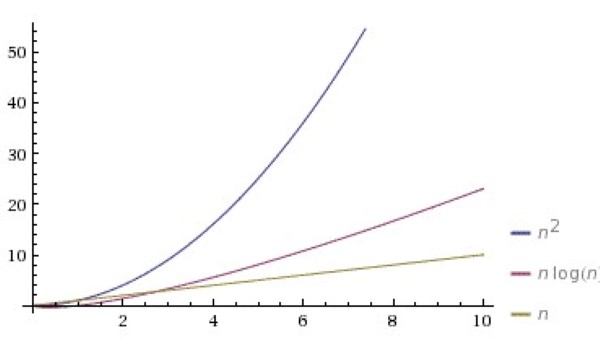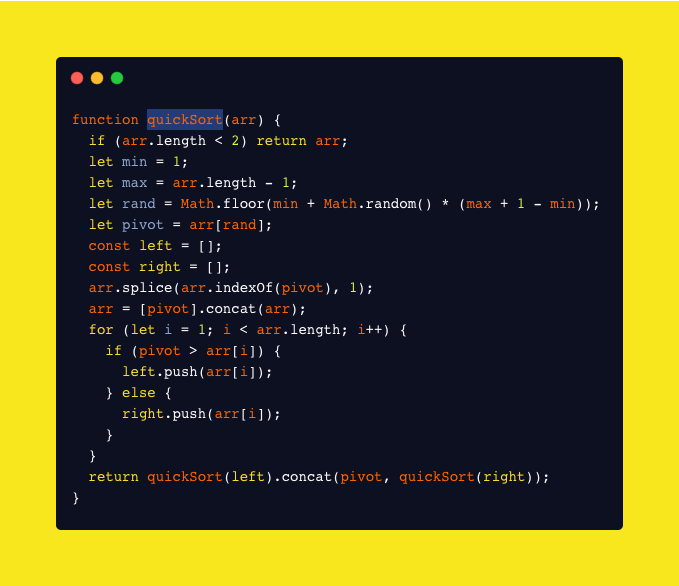

夯实算法-快速排序 [ 果糖酱的博客 ]
source link: https://answer518.github.io/2020/03/01/quick-sort-algorithm-in-javasript/?
Go to the source link to view the article. You can view the picture content, updated content and better typesetting reading experience. If the link is broken, please click the button below to view the snapshot at that time.

夯实算法-快速排序
2020-03-01 / / 168 点击 / 阅读耗时 7 分钟
快速排序是最常用的排序算法了。它的复杂度为 O(nlog^n),且它的性能通常比其他的复杂度为 O(nlog^n) 的排序算法要好。
另外,通常在面试中有极大的可能性,面试官会让你手写写一个快速排序算法。
所以学会快速排序对实际工作或是面试都是很重要的,现在就开始吧~
首先定义一个快速排序函数:
1 | function quickSort(arr) { |
现在开始完成 quickSort 的核心功能,快速排序是基于递归算法实现的。因此我们需要添加结束条件:
1 | function quickSort(arr) { |
这意味着如果传入的数组长度小于2,直接返回即可。因为我们不需要对一个空数组或只有一个元素的数组进行排序。
下一步,定义三个重要的变量:
pivot - 主要用于在数组中选择一个与其他元素进行比较的元素(在本例子中用的是数组第一个元素)
left - 小于pivot的元素存放的数组
right - 大于pivot的元素存放的数组
1 | function quickSort(arr) { |
现在我们需要在左和右传递数组的元素数组。这需要一个 for 循环。
1 | function quickSort(arr) { |
这里我们遍历数组的每个元素和 pivot 比较,小于 pivot 加入 left 数组,否则加入 right 数组。
假设我们传入的是如下的数组:[5, 2, 6, 1, 30, -10]
pivot 取数组的第一个元素:5。首先5和2比较。2小于5(2 < 5),因此2添加到 left 数组;然后比较5和6,6大于5(6 > 5),然后把6加到 right 数组。
最后 left 和 right 分别为:
- left: [2, 1, -10]
- right: [6, 30]
现在你可能有一个问题: “如何实现数组排序?“ 答案很简单。我们需要递归调用快速排序数组以及在它们之间插入 pivot 。为什么?因为 pivot 位于 left 数组元素和 right 数组的元素。
最终, 让我们回到代码。返回最终排序后的数组:
1 | return quickSort(left).concat(pivot, quickSort(right)); |
为了帮助理解快速排序算法,还是以 [5, 2, 6, 1, 30, -10] 为例,详细解释一下排序的过程:
第一次迭代后的结果为:
- left: [2, 1, -10]
- right: [6, 30]
分别对 left 和 right 进行递归调用,意味着 2 作为 pivot 分别与 1, -10 进行比较,整个快速排序的执行过程:
1 | arr: [5, 2, 6, 1, 30, -10] pivot: 5 |
最终,将每个划分后的数组通过 concat() 连接起来就是最终排好序的最终数组。
1 | return quickSort(left).concat(pivot, quickSort(right)); |
完整的代码:
1 | function quickSort(arr) { |
快速排序算法的时间复杂度是O(nlogn), n 是一个数组的长度。最坏的情况下是O(n²)。

为了达到平均的情况下,我们需要随即选择一个数组项作为主元(pivot)。我通常这样做:

我相信在阅读这篇文章之后你已经完全理解快速排序算法,面试的时候也会更有信心。
如果你有更简单的解释JS的快速排序算法。请通过评论告诉我!
</div
Recommend
About Joyk
Aggregate valuable and interesting links.
Joyk means Joy of geeK